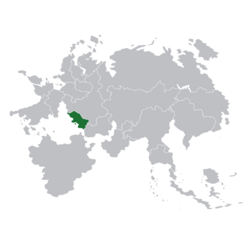Abramea
Union of Abramea האיחוד של אברם Ikhúd shel Avram | |
|---|---|
|
Flag | |
| Motto: "???" ("???") | |
| Anthem: ??? ("???") | |
 location of Abramea (green) | |
| Capital and largest city | Jerach |
| Official languages | Abramean |
| Recognised regional languages | |
| Demonym(s) | Abramean |
| Government | Unitary socialist kibbutz republic under a socialist democracy |
| Shimon ben-Yaakov | |
| Levana bat-Meshulam | |
| Legislature | General Sanhedrin |
| Independence from Lavaria | |
• Declared | 11 July 1928 |
• Recognised | 22 May 1933 |
| Area | |
• Total | 517,945 km2 (199,980 sq mi) |
| Population | |
• 2020 estimate | |
| GDP (PPP) | estimate |
• Total | 1.464 trillion |
• Per capita | 38,239 |
| GDP (nominal) | estimate |
• Total | 761.842 billion |
• Per capita | 19,904 |
| HDI | very high |
| Driving side | left |
| Internet TLD | .av |
Abramea (Abramean: אברם, tr. Avram), officially the Union of Abramea (Abramean: האיחוד של אברם, tr. Ikhúd shel Avram), is a sovereign socialist state in southwestern Cathan. The country stretches from the Bosphoric Sea to the arid Red Mountains, bordering Kherita to the south, Ashira and ??? to the east, and ??? to the north. Abramea has a population of 38.3 million, which is heavily concentrated close to the coast, as the country's interior is sparsely populated. The historic city of Jerach is the capital and largest city.
Humans first arrived in Abramea around 90,000 years ago. A number of Abreo-Ashiran peoples emerged in the region, and established city kingdoms during the Bronze Age. The territory had been largely united under the rule of the Kingdom of Jerach by the Iron Age, which coincided with the emergence of Gyhad. This ancient kingdom became a client of the Tiberian Empire around 10 BCE, and was fully subjugated by the Tiberians in 174 CE. After the collapse of the Empire, a number of feudal realms emerged across the province, emulating the situation during antiquity.
middle history
Opposition to colonisation, led by the labour movement and socialist leaders in Abramea, resulted in the country's declaration of independence in 19??, which led to the Abramean Revolutionary War as a theatre in the Second Continental War. Abramea was established as a socialist state, and was immediately recognised by Arlyon. Abramea's independence was recognised internationally in 19??, after the war came to a conclusion.
post-indy history
Abramea is a regional power in southwestern Cathan, with a large economy that has historically focused on oil extraction and pasturing, but has recently shifted to telecommunications, manufacturing, information technology and services. Abramea has a very high ranking on HDI, but is considered a middle-income country. The Union maintains a good standard of living relative to its neighbours, with a welfare state and modern education system. It is a unitary socialist state, which has been defined as both a kibbutz republic and a socialist democracy. Abramea is a member of the Concert of Nations and the Jerach Pact.
Etymology
The common Wellish exonym of Abramea is directly derived from the native Abramean endonym Avram (אברם). The name Avram is itself a derived contraction of haAretz Avram or Eretz Avram, the Land of Abraham, itself derived from the B'nai Avram, the tribe of Abraham. A similar exonym, Avrea is also in use, and was the more commonly used name for the country historically.
History
Geography
Government and politics
first leader is Isaiah ben Yesochor Avavram
Economics
Demographics
Ethnic groups
Religion
Languages
Abramean is the sole official language in Abramea, and is by far the most widely spoken. It is also considered the national language. Despite its prominence, there are a number of other, smaller minority languages spoken in the country, primarily Ashiri and Calcidian. These and other minority languages have varrying levels of recognition across the country; Ashiri in particular is far more commonly spoken in the eastern interior, while Calcidian speakers are concentrated in the southwest, along the border with Kherita. In these regions, the minority languages are essentially co-official with Abramean.
Secondary languages are encouraged by the Abramean education system, and students are encourged to learn a second language alongside their mother tongue. Popular choices include Arlyonish, Kheritan, Sintelian and Narrish. If Abramean is not already the students' mother tongue, then they are taught Abramean.



